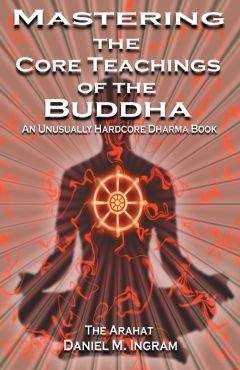Daniel Ingram - Mastering the Core Teachings of Buddha - An Unusually Hardcore Dharma Book
На сайте mybooks.club вы можете бесплатно читать книги онлайн без регистрации, включая Daniel Ingram - Mastering the Core Teachings of Buddha - An Unusually Hardcore Dharma Book. Жанр: Прочее издательство -,. Доступна полная версия книги с кратким содержанием для предварительного ознакомления, аннотацией (предисловием), рецензиями от других читателей и их экспертным мнением.
Кроме того, на сайте mybooks.club вы найдете множество новинок, которые стоит прочитать.

Daniel Ingram - Mastering the Core Teachings of Buddha - An Unusually Hardcore Dharma Book краткое содержание
Mastering the Core Teachings of Buddha - An Unusually Hardcore Dharma Book читать онлайн бесплатно
It is not possible to investigate this state, as it is too
incomprehensible, or to move to a higher state. Thus, as this state ends, the meditator may return to lower states or turn to insight practice in the afterglow of this state. It should also be noted that, in contrast to the previous seven jhanas, the issue of “hard” or “soft” jhana that relates to how solidly one is in a state does not apply to the eighth jhana. You are either in it or you are not.
163
The Formless Realms
The eighth jhana may have a certain stability that nothingness doesn’t due to the inability to make sense of it or go beyond it. Thus, the mind may move fairly quickly from boundless consciousness, through nothingness, and drop into the eighth jhana for a while, though the vaguest hint of attention to anything specific demolishes this state instantly. It is also possible to sort of drift up and down through the various formless realms, and shifting back down to lower jhanas after being up in higher jhanas such as this one can lend a great deal of intensity to them.
The eighth jhana can be sorted out from the attainment of
emptiness by a number of signs having to do with the way the entrance to the state presents itself (i.e. not being one of the Three Doors and thus not relating to the rapid and clear presentation of one of the Three Characteristics three or four times in quick succession), what came before this (i.e. not the stages of insight, see below) and the fact that there is still some subtle sense of a state and thus relative reality.
Just to drive this point home, an important feature of concentration practices is that they are not liberating in and of themselves. Even the highest of these states ends. The afterglow from them does not last that long, and regular reality might even seem like a bit of an assault when it is gone. However, jhana-junkies still abound, and many have no idea that this is what they have become. I have a good friend who has been lost in the formless realms for over 20 years, attaining them again and again in his practice, rationalizing that he is doing dzogchen practice (a type of insight practice) when he is just sitting in the 4th-6th jhanas, rationalizing that the last two formless realms are emptiness, and rationalizing that he is enlightened. It is a true dharma tragedy.
Unfortunately, as another good friend of mine rightly pointed out, it is very hard to reach such people after a while. They get tangled in golden chains so beautiful that they have no idea they are even in prison, nor do they tend to take kindly to suggestions that this may be so, particularly if their identity has become bound up in their false notion that they are a realized being. Chronic jhana-junkies are fairly easy to identify, even though they often imagine that they are not. I have no problem with people becoming jhana-junkies, as we are all presumably able to take responsibilities for our choices in life. However, 164
The Formless Realms
when people don’t realize that this is what they have become and pretend that what they are doing has something to do with insight practices, that’s annoying and sad.
To try to clearly differentiate between concentration practice and insight practice, I will now give a detailed description of the stages of insight so that the contrast will be as clear as possible. Pay careful attention to how different these descriptions are from those of the pure concentration states.
165
Mastering the Core Teachings of the Buddha
24.THE PROGRESS OF INSIGHT
The progress of insight is a set of stages that diligent meditators pass through on the path of insight. Some of the “content based” or psychological insights into ourselves can be interesting and helpful, but when I say “insight,” these stages are what I am talking about. Just so that you have seen the whole list of the names of these stages, the formal names of stages of insight in order are:
1. Mind and Body
2. Cause and Effect
The pre-vipassana stages
1st jhana
3. The Three Characteristics
4. The Arising and Passing Away
2nd jhana
5. Dissolution
6. Fear
7. Misery
The Dark Night
3rd jhana
8. Disgust
(dukkha ñanas)
9. Desire for Deliverance
10. Re-observation
11. Equanimity
4th jhana
12. Conformity
13. Change of Lineage
14. Path
15. Fruition
Nirvana (one of two meanings)
16. Review
I will give detailed descriptions of them shortly.
I will refer to these stages by their shortened titles, their numbers and occasionally short-hand slang. These are formally known as
“Knowledge of” and then the stage, e.g. “Knowledge of Mind and Body,” but I will just use the part after the “of.” They are also called
“ñanas,” which means “knowledges”, usually with a number, as in “the First Ñana.” Notice that I use the word stage rather than state. These are stages of heightened perception into the truth of things, opportunities to see directly how things actually are, but they are not seemingly stable states as with concentration practice. The jhanaic groupings refer to vipassana jhanas, which will be covered in more depth later, but they borrow their perspectives and certain fundamental aspects from their
The Progress of Insight
samatha jhana equivalents. In other ways they may diverge widely from the experience of pure samatha jhanas.
One of the most profound things about these stages is that they are strangely predictable regardless of the practitioner or the insight tradition. Texts two thousand years old describe the stages just the way people go through them today, though there will be some individual variation on some of the particulars today as then. The Christian maps, the Sufi maps, the Buddhist maps of the Tibetans and the Theravada, and the maps of the Khabbalists and Hindus are all remarkably consistent in their fundamentals. I chanced into these classic experiences before I had any training in meditation, and I have met a large number of people who have done likewise. These maps, Buddhist or otherwise, are talking about something inherent in how our minds progress in fundamental wisdom that has little to do with any tradition and lots to do with the mysteries of the human mind and body. These stages are not Buddhist but universal, and Buddhism is merely one of the traditions that describes them, albeit unusually well.
The progress of insight is discussed in a number of good books, such as Jack Kornfield’s A Path with Heart in the section called Dissolving the Self, which I highly recomment. A very extensive, thorough, accessible and highly recommended treatment of it is given in Mahasi Sayadaw’s works The Progress of Insight and Practical Insight Meditation (on BPS out of Sri Lanka), a partially castrated version of which appears in Jack Kornfield’s Living Dharma. It should be noted here that Practical Insight Meditation is my favorite dharma book of all time with no close competitors. If you can ever lay your hands on a copy, do so! Even the section of it that appears in Living Dharma is much better than having access to none of it at all.
Sayadaw U Pandita’s In This Very Life also covers this territory, and is a bit of a must have for those who like lists and straight-up Theravada, but he leaves out a lot of juicy details. The Vis
uddhimagga , a 5th
Century text by Buddhaghosa, also does a nice treatment of these stages, and contains some interesting and hard to find information. It focuses largely on the emotional side-effects and thus misses many useful points.
Another good but brief map appears in Ven. Khenpo Karthar
Rinpoche’s Dharma Paths. You could also check out Bhante
167
The Progress of Insight
Gunaratana’s The Path of Serenity and Insight if you would like to know the dogma well. It is a thorough and scholarly work.
Matthew Flickstein’s Swallowing the River Ganges is a light
treatment of basic Buddhist concepts and contains a very superficial treatment of the stages of insight. It is kind of like what would happen if you condensed a medical school textbook down to a 5th grade science text. It focuses almost entirely on the emotional side effects and thus misses a huge amount that is worthy of discussion, but it comes from a good place and is harmless enough. It doesn’t add anything to the above sources but is easy to read.
There are many less accessible maps of insight as well. The Tibetan Book of the Dead
, Li
beration Through Hearing in the Bardo requires
some prior familiarity with this territory to sort out the wild symbolic imagery. A 12th Century Sufi map is given in Journey to the Lord of Power by Ibn 'Arabi, but again the medieval symbolism is somewhat hard to untangle unless you are already personally familiar with these stages. It also provides a very interesting if quite cryptic description of the higher stages of realization. St. John of the Cross’ The Dark Night of The
Soul does a good job of dealing with the most difficult of the insight stages. His map is called The Ladder of Love. Unfortunately, the translation of the medieval Spanish and thickness of complex Catholic dogma make it a fairly inaccessible.
I strongly recommend that you consult some of these other sources, particularly the first five mentioned. While I consider the treatment of the stages of insight that follows shortly to be by far the most comprehensive and practical explanation of the stages of insight ever written, and I mean that honestly, there are still lots of great points made in those books, and you should check them out. There is a huge amount of valuable information left out in all of these sources, perhaps due to the Mushroom Factor, but perhaps due to some of the
difficulties in describing all the little nuances of the subject in all its possible variations. Thus, working with a teacher who has personal mastery of these stages (regardless of what they call them) is an extremely good idea most of the time.
The model terminology I am using is from the ancient
commentaries on the Pali Canon of the Theravada tradition. This 168
The Progress of Insight
model is used mostly in Burma but is also used to some degree in the other Theravada traditions. Zen is quite aware of these stages, as all Zen Masters had to go through them and continue to do so, but they tend not to name them or talk about them, as is their typical style. This can be helpful, as people can get all obsessed with these maps, turning them into a new form of useless content and a source of imprisoning identification and competition. This is the ugly shadow side of goal-oriented or map-based practice, but it often (though not always) may be overcome with honest awareness of this fact.
Luckily, if the meditator really is into insight territory, continued correct practice has a way of unsticking them given time. Also, when the proverbial stuff is hitting the fan, having a map around can really help the meditator not make too many of the common and tempting
mistakes of that stage, as well as provide the meditator with faith that that they are on the right track when they hit the hard or weird stages.
These stages can significantly color or skew a meditator’s view of their life until they master them, and it can be very helpful to remember this when trying to navigate this territory and keep one’s job and relationships functioning. Those who do not have the benefit of the maps in these situations or who choose to ignore them are much more easily blindsided by the psychological extremes and challenges which may sometimes accompany stages such as The Arising and Passing Away and those of The Dark Night.
While many people don’t want to know the maps for various
reasons (such as their own unexamined insecurities), I suspect that many more people could get a lot farther in their practice if they did know them. At their very least, the maps clearly demonstrate that there is vastly more to all this than just philosophy or psychology. They also clearly and unambiguously point to how the game is played step by step and stage by stage, what one is looking for and more importantly why, and give guidelines for how to avoid screwing up along the way. Why people wouldn’t want to know these things is completely beyond me.
They fill in the juicy details of the seemingly vast gap from doing some seemingly boring and simple practice to getting enlightened.
Further, providing all of this extremely precise information on exactly what to do puts the responsibility for progress or a lack thereof clearly 169
The Progress of Insight
on the meditator (e.g. you), which is exactly where it should be. If after reading this book you don’t put this extremely powerful information into practice, the fault is your own.
There is considerable evidence that the lack of this information in insight traditions that don’t use the maps has been one of the primary obstacles to progress. On the other hand, the maps can sometimes cause furious competition and arrogance in the traditions that do use them, as well as harmful fixation on purely future-oriented goals. Please, do your very best to avoid these sorts of problems.
The more intense, consistent and precise the practice, the easier it is to see how the maps apply. The more energy, focus and consistency is put into practice, the more dramatic and even outrageous these stages can be. If these stages unfold over long periods of time and gently, it can be more difficult to see the progression through them, though it does happen regardless. Certain emphases in practice, such as Mahasi Sayadaw style “noting” practice, particularly on intensive retreats, seem to produce a clearer appreciation of the maps, and some individuals will have an easier time seeing how these maps apply than others will.
Each stage is marked by very specific increases in our perceptual abilities. The basic areas we can improve in are clarity, precision, speed, consistency, inclusiveness and acceptance. It is these improvements in our perceptual abilities that are the hallmarks of each stage and the gold standard by which they are defined and known. Each stage also tends to bring up mental and physical raptures (unusual manifestations). These are fairly predictable at each stage and sometimes very unique to each stage. They are secondary to the increase in perceptual thresholds of ways by which we may judge whether or not we are in a particular stage.
Each stage also tends to bring up specific aspects of our emotional and psychological makeup. These are also strangely predictable, but these are not as reliable for determining which stage is occurring. They are suggestible, ordinary, and will show more variation from person to person. However, when used in conjunction with the changes in perceptual threshold and the raptures, they can help us get a clearer sense of which stage has been attained. Further, these stages occur in a very predictable order, and so looking for a pattern of stages leading one to the next can help us get a sense of what is going on. Thus, when 170
The Progress of Insight
reading my descriptions of these stages, pay attention to these separate aspects: the shift in perceptual threshold, the physical and mental raptures, the emotional and psychological tendencies, and the overall pattern of how that stage fits with the rest.
Похожие книги на "Mastering the Core Teachings of Buddha - An Unusually Hardcore Dharma Book", Daniel Ingram
Daniel Ingram читать все книги автора по порядку
Daniel Ingram - все книги автора в одном месте читать по порядку полные версии на сайте онлайн библиотеки mybooks.club.




